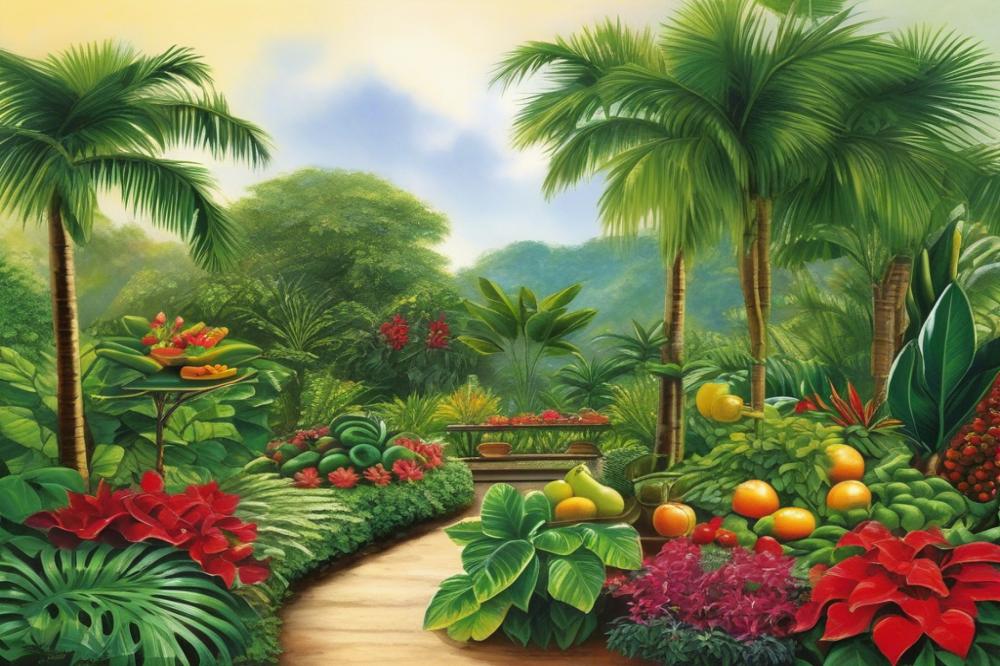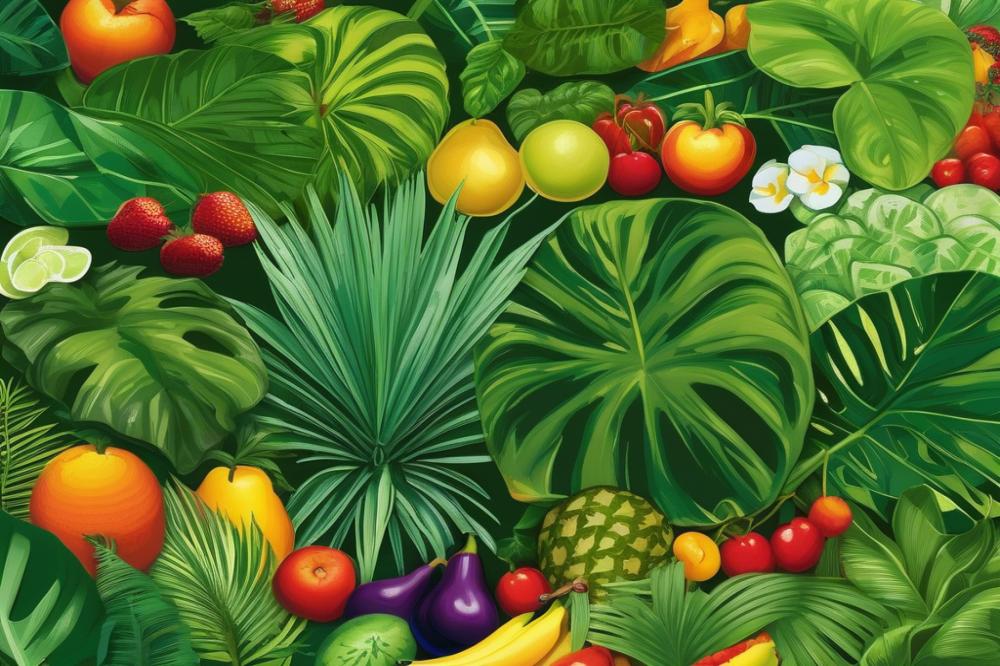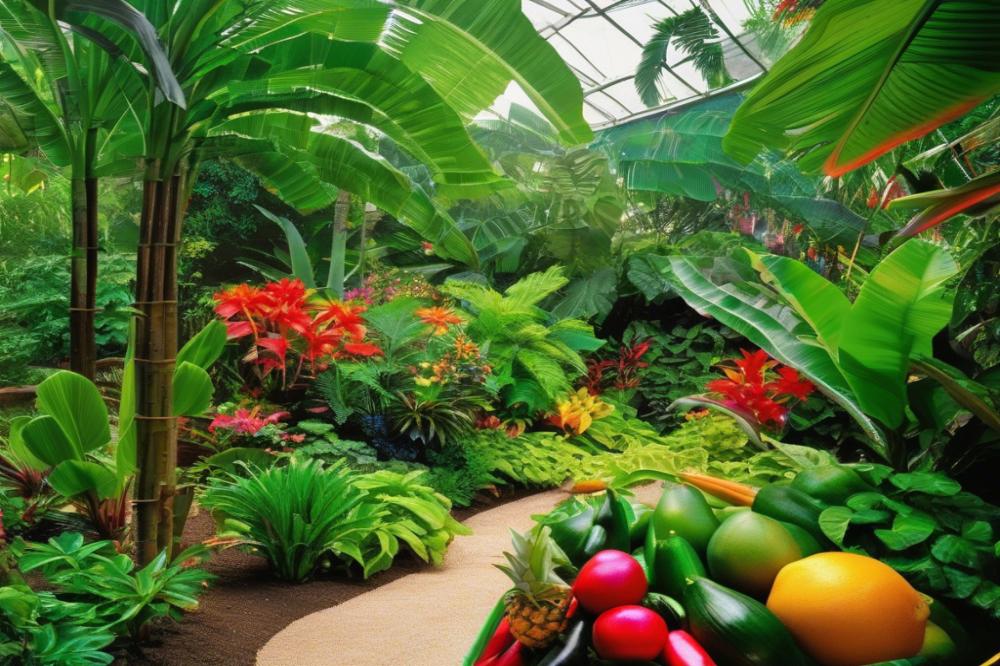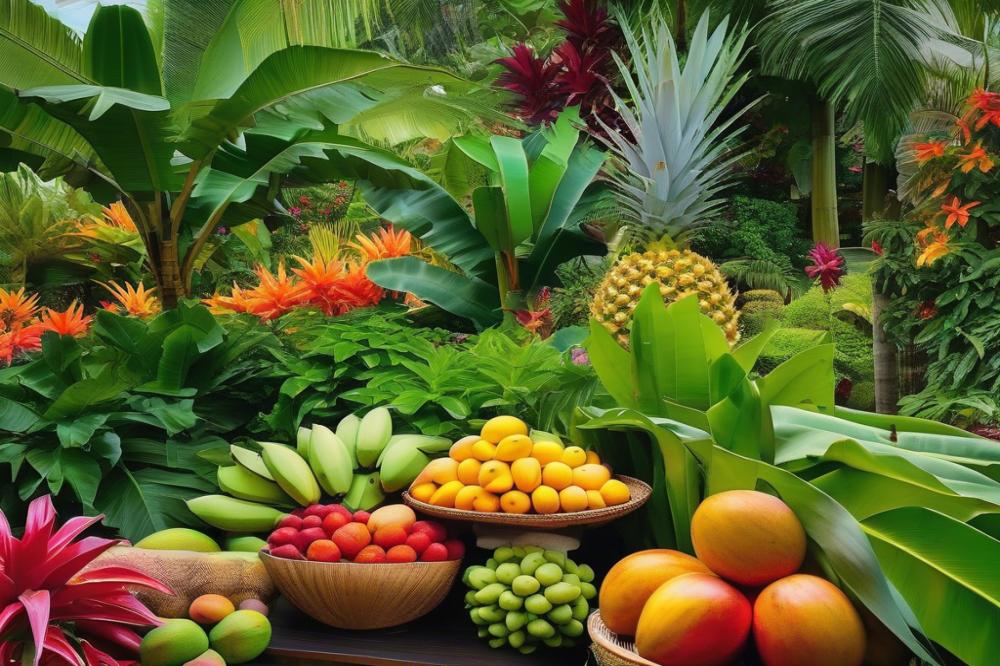Incorporating edible plants in Tropical gardens
Tropical gardening offers a vibrant and lush environment, filled with diverse plant species and rich soils. This region enjoys a warm climate year-round, making it perfect for growing a wide variety of plants. Such conditions not only foster beauty but also create opportunities for food production. The art of gardening in these areas often involves practices like permaculture and companion planting, which enhance sustainability. Emphasizing the cultivation of herbs, vegetables, and even fruit trees can transform how we think about our green spaces.
Incorporating edible plants into Tropical gardens promotes sustainability and boosts biodiversity. Gardens become mini-ecosystems when we mix ornamental with practical planting. This practice supports soil health and provides habitats for various species. Harvesting food directly from one’s garden can also reduce the need for store-bought produce. Thus, home gardens work toward achieving food security in communities while simultaneously aiding the environment.
Organic gardening practices are essential. These methods avoid harmful chemicals, benefiting both the gardener and local wildlife. With thoughtful garden design, individuals can create stunning settings that thrive while providing nutritional benefits. A variety of plants can coexist harmoniously, demonstrating how beauty and utility can blend effortlessly. Overall, tropical gardens are ideal for those wishing to contribute to healthier ecosystems while enjoying fresh, homegrown food.
Understanding Edible Plants in Tropical Climates


Tropical gardens can be a feast for the senses. The warm temperatures and rich soil offer great opportunities for growing various fruits, vegetables, and herbs. Plant selection is vital. Many options thrive in these climates, contributing to a vibrant, sustainable gardening experience.
Fruits like mangoes, papayas, and guavas flourish in the heat. These trees not only produce delicious snacks but also provide shade. Happy plants lead to healthier soil. Vegetables such as eggplants, peppers, and sweet potatoes are suited for direct sunlight. They can grow year-round, giving a continuous harvest. Herbs like basil, cilantro, and lemongrass are not only easy to grow but also enhance flavors in dishes.
Climate considerations are key in this process. Understanding rainfall patterns and humidity levels impacts growth. Select plants that can thrive with minimal care. Embracing permaculture techniques will boost biodiversity. Utilizing companion planting improves soil health, too. Certain plants benefit from being close to one another. For instance, planting tomatoes near basil can enhance growth while repelling pests.
Organic gardening methods are highly effective in tropical regions. Using compost and organic fertilizers improves the nutrient content of the soil. This approach supports a thriving ecosystem. Many gardeners also find that integrating native plants promotes resilience. These plants are naturally suited to local conditions and often require less water.
Garden design plays an essential role. Planning layout can influence which plants grow best together. Consider vertical gardening for herbs and climbing vegetables. This strategy maximizes space while adding beauty. Grouping plants together not only looks appealing but also supports the overall health of the garden. For those new to gardening, starting small is wise. Focus on a few types of plants first and expand as you gain experience.
In summary, tropical climates offer countless possibilities for growing diverse flora. Choosing the right fruits, vegetables, and herbs is the first step toward a lush, productive garden. By considering climate, employing sustainable practices, and carefully designing your space, you can create a thriving edible paradise in your backyard.
Permaculture Principles for Tropical Edible Gardens


Permaculture is a design methodology that seeks to create harmonious environments. Its principles resonate deeply within the context of tropical gardening. Tropical regions are rich in biodiversity and offer a suitable canvas for sustainable gardening practices. By applying permaculture principles, gardeners can foster ecosystems that not only function well but thrive naturally.
One key aspect of permaculture is the concept of companion planting. This technique involves placing certain plants near each other to benefit from their unique qualities. For instance, growing nitrogen-fixing plants alongside fruit trees and vegetables can enhance soil health. Such thoughtful garden design ultimately promotes a vibrant, productive space.
Integrating herbs into the landscape adds flavor and function. Many herbs attract beneficial insects, which can help with pest control. A diverse set of plants can create a balanced ecosystem that boosts biodiversity. Choosing a variety of plants enriches the garden’s overall health and resilience.
Consider the layout when designing a tropical garden. Strategically positioning fruit trees can provide shade for vulnerable plants while their fallen leaves nourish the soil. This layering approach mimics natural ecosystems, allowing sunlight to penetrate while retaining moisture. It’s a creative way to utilize space efficiently while embracing sustainable gardening methods.
Building healthy soil is another cornerstone of permaculture. Enriching the soil with organic matter enhances the growth of all plants. Practices such as mulching and composting can significantly improve soil fertility. Healthy soil leads to healthier plants, which results in a thriving garden.
Incorporating a variety of vegetables into your garden fosters resilience. A mixture of different crops makes it harder for pests to wipe out an entire garden. This diversity creates a protective barrier against disease and encourages a more stable microenvironment.
Finally, permaculture emphasizes the importance of observing natural patterns. Taking the time to watch how sunlight moves, how water drains, and how living organisms interact will guide your design choices. Understanding these elements can greatly enhance the effectiveness of your tropical garden.
Companion Planting for Enhanced Growth


Companion planting is a strategy where different plant species are grown together for mutual benefits. This technique can lead to enhanced growth, pest control, and improved soil health. By understanding how plants interact, gardeners can create more productive and sustainable gardens.
In tropical climates, certain combinations of herbs, vegetables, and fruit trees work particularly well together. For example, planting basil near tomatoes can enhance their growth while also keeping pests away. Basil repels harmful insects like aphids and whiteflies. Another effective pair is corn and beans. Corn provides a natural support for the climbing beans, making efficient use of vertical space.
Additionally, planting marigolds alongside vegetable crops helps deter nematodes and various pests. This relationship not only boosts the vegetables’ health but also increases biodiversity in the garden. Using permaculture principles can further enhance these companion planting strategies for a thriving ecosystem.
Relationships among plants extend beyond pest control. The three sisters method—a combination of corn, beans, and squash—is a traditional Native American technique that shows how plants can work together. The corn provides a tall structure, beans fix nitrogen in the soil, and squash covers the ground to block weeds. Such combinations maximize yields while fostering a strong garden design.
Employing these practices aligns perfectly with the goals of organic gardening and sustainable gardening. Gardeners should consider layering their plants strategically. Doing this can improve airflow, reduce humidity, and decrease the likelihood of disease. Keeping this in mind can lead to healthier crops and more efficient use of your planting space.
By incorporating companion planting, gardeners not only increase their harvest but also contribute to the well-being of the environment. It fosters a balance that encourages a healthier community of plants. Each plant plays a part, creating a dynamic and resilient garden. This approach not only brings beauty but also promotes a deeper understanding of plant relationships and their contributions to overall garden success.
Soil Health and Fertility Management


Soil health plays a critical role in the success of any tropical garden. Rich, fertile soil supports plant growth, leading to a plentiful harvest. Without nutrient-dense soil, even the most resilient plants can struggle to thrive.
Organic gardening practices enhance soil quality. They promote the use of natural compost and mulch rather than synthetic fertilizers. Composting kitchen scraps and yard waste is a simple way to recycle nutrients. This process improves soil structure and moisture retention, benefiting all types of plants.
Permaculture techniques also promote sustainability. These methods encourage planting fruit trees, vegetables, and herbs in harmony with natural ecosystems. When these plants coexist, they create a balanced environment that supports biodiversity.
Companion planting is another effective technique. Certain plants enhance each other’s growth when planted together. For example, planting basil alongside tomatoes can deter pests and boost flavor. By integrating these strategies, gardeners can cultivate a thriving ecosystem.
The relationship between healthy soil and plant productivity cannot be overstated. Nutrient-rich soil fosters diversity, attracting beneficial insects and microbes. This, in turn, enhances plant health and leads to abundant yields.
Regular soil testing can help maintain optimal conditions. Understanding the pH and nutrient levels allows for informed adjustments. Natural amendments, like bone meal or fish emulsion, can improve deficiencies without harming the environment.
Engaging in sustainable gardening not only promotes health but also boosts local wildlife habitats. Birds, bees, and other beneficial creatures contribute to garden vitality. By prioritizing soil health, gardeners encourage a healthy ecosystem that expands beyond their backyards.
Incorporating Fruit Trees in Tropical Gardens
Tropical gardens provide a fantastic opportunity to grow delicious fruit trees. Many trees thrive in warmer climates. Some popular options include mango, banana, papaya, and guava. These varieties not only offer tasty produce but also enhance your garden’s beauty.
Planting fruit trees requires some planning. Start by selecting a suitable location with plenty of sunlight. Consider spacing them far enough apart to allow for their mature size. This approach helps create an open area for air circulation. Good soil health is vital; amend the soil with compost to support growth. It’s also essential to choose healthy saplings from a reliable source.
Maintenance is a continuous process. Regular watering is crucial, especially in dry spells. Organic gardening practices, like mulching, help retain moisture while suppressing weeds. Pruning your trees encourages better airflow and can lead to more fruitful harvests. Applying natural fertilizers will promote sustainable gardening.
Companion planting pairs well with fruit trees. Herbs and vegetables thrive nearby, benefiting from the protection of larger trees. Basil loves to grow near tomatoes, for instance. They can help produce a diverse ecosystem, improving biodiversity around your garden.
Fruit trees add many advantages. They provide shade, making your garden a comfortable retreat on hot days. Furthermore, trees create habitat for various birds and beneficial insects. These creatures play key roles in pollination and pest control, enriching your garden’s ecosystem. Harvesting fresh fruit brings satisfaction and joy, making every effort worthwhile.
Integrating fruit trees into your overall garden design is an excellent choice. Your tropical garden could transform into a vibrant oasis of color and taste. Imagine harvesting fresh mangoes while sipping your morning coffee. This unique feature can inspire others to adopt similar practices. Embrace the opportunity to create an organic paradise right in your backyard.
Herbs and Vegetables for Tropical Gardens
Creating a tropical garden filled with herbs and vegetables is not only enjoyable but also rewarding. Many herbs thrive in this warm climate, including basil, cilantro, and lemongrass. These plants add flavor to meals and can be used fresh or dried. Vegetables such as tomatoes, peppers, and eggplants flourish in the heat, providing essential nutrients. Sweet potato and taro also do well and can be good choices for unique textures.
Growing these crops requires attention and care. Choose the right location for your plants. They need plenty of sunlight, ideally six to eight hours each day. Rich, well-draining soil is crucial. Adding organic matter like compost can enhance soil health. Regular watering, especially in dry seasons, will keep your plants thriving. Mulching around plants helps retain moisture.
Companion planting serves as an effective method to boost growth and manage pests. For instance, planting marigolds near vegetables can deter harmful insects. Similarly, herbs like basil can help repel pests that affect tomatoes. This strategy aligns well with permaculture principles, promoting biodiversity within the garden. A diverse garden is less susceptible to diseases and pests.
Incorporating fruit trees can provide additional benefits. Tropical varieties such as mango, papaya, and banana trees add beauty and yield delicious fruit. These trees also offer shade, which can help protect tender plants from the harsh sun. This layer of greenery contributes to the ecosystem of your garden. Having both herbs and trees creates a balanced environment.
When thinking about garden design, consider the vertical space. Using trellises for climbing vegetables like beans or cucumbers can maximize your garden area. Vertical gardening aids airflow, reducing disease risk. It also creates a more visually appealing garden, making harvests more accessible.
Adopting sustainable gardening practices is vital for long-term success. Using organic methods to control pests helps preserve the environment. Crop rotation is another excellent technique; it keeps the soil healthy while minimizing pests and diseases. Encouraging beneficial insects like ladybugs can also maintain a balance in your garden.
Growing a variety of herbs and vegetables can transform your tropical garden into a vibrant ecosystem. The combination of these plants can enhance both your meals and your gardening experience. Plus, it supports a healthier planet.
Garden Design for Edible Plants
Creating a layout for a tropical garden that includes edible plants can transform your outdoor space. Start by assessing the area you have available. This means considering both the size and the shape of your garden. Use every inch wisely, making sure to maximize space utilization. Vertical gardening is one effective method. It not only saves ground space but also adds visual interest.
Aesthetic appeal should remain a priority. Brightly colored fruits and herbs can bring vibrancy to your garden. Mixing ornamental flowers with herbs and vegetables creates an inviting atmosphere. When planning, consider planting in clusters. Grouping compatible plants together, a practice known as companion planting, encourages healthy growth. This method also enhances the garden’s beauty.
Accessibility is crucial for the upkeep of your tropical paradise. Paths should make it easy to reach all plants. Raised beds can also help keep the garden manageable while improving soil health. They allow for better drainage and easier access for planting and harvesting. Remember to plan for the growth habit of the plants you choose. Ensure that larger plants do not overshadow smaller ones.
Fruit trees serve as magnificent focal points. Incorporating them offers shade and benefits the smaller plants below. Consider spacing them not only for growth but also for airflow. This can prevent diseases and pests, contributing to sustainable gardening. Adding layers to your garden design can also support biodiversity. A rich variety of plants attracts pollinators and beneficial insects, creating a healthier environment.
Herbs are another fantastic addition. They can fit into small spaces between larger plants. Not only do they enhance meals, but they also provide natural pest deterrents. Organic gardening practices will keep your garden thriving without harmful chemicals. Composting kitchen scraps can improve soil health and support your growing plants.
Lastly, be open to experimenting with your garden layout. Tropical zones offer diverse climates, which can lead to unique plant pairings. Explore various combinations to discover what works best in your specific setting. Your garden can be both beautiful and functional, providing fresh produce for your household. Embrace the joy of nature while nurturing a space that reflects your personality.
Bringing It All Together
Incorporating edible plants into tropical gardens offers numerous benefits. Not only do these plants provide fresh, nutritious food, but they also promote a sustainable way of living. A diverse garden creates a healthier ecosystem. This enhances biodiversity and can attract beneficial insects. More variety in your garden means fewer pests and diseases, leading to a thriving environment.
Embracing sustainable practices like permaculture can make your gardening experience even more rewarding. Implementing methods such as companion planting fosters natural relationships among plants. This approach boosts growth and reduces the need for chemical fertilizers and pesticides. By carefully designing your garden space, you can create a self-sustaining environment while enjoying delightful produce.
Gardeners should feel encouraged to take action today. Start small by introducing a few edible plants into your existing garden. Explore different combinations and see what thrives. Experimentation not only enhances your gardening skills but also makes the process exciting. Every step towards integrating food production with beautiful plants contributes to a healthier planet.
As you plan your garden, remember the impact of your choices. Inspired gardening can lead to a positive ripple effect in your community. More people growing their own food can promote wellness, reduce carbon footprints, and foster a closer connection to nature. Plant a few crops, and enjoy the fruits of your labor while contributing to a more sustainable future.



